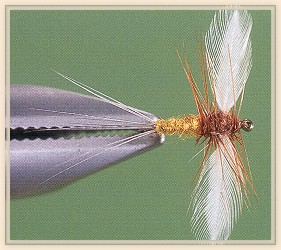Female Trico Hen Spinner
By Dave Hughes
Most mayflies can be matched with dressings
that work for more than one species. You need
do no more than observe the size, form, and color
of a collected specimen, and choose a pattern that
matches it and is appropriate for the water over
which you'll be casting it.
Tricos are a special case. They're rarely important in
the nymph or dun stages, almost always important as spinners
if they fall to the waters you're on. Because they're
so tiny, size 20 and at times even size 26, you need
to match them with patterns tied specifically for them.
Take some time, after the frenzy of a morning spinner
fall of Tricos, to collect some specimens and observe
them closely. Use a loup or handheld magnifying
glass. Note their features, and compare them to the
flies you've tied to match them. You might find some
tweaking of what your are tying beneficial in your own
fishing.
Materials List:
Hook: Standard dry fly, 1x fine, size 20 to 24.
Thread: Brown 8/0.
Tail: Blue dun hackle fibers, split.
Abdomen: Olive fur or synthetic dubbing.
Wings: White or pale gray hen hackle tips, spent.
Hackle: Brown, clipped top and bottom.
Thorax: Brown fur or synthetic dubbing.
Instructions - Female Trico Hen Spinner:
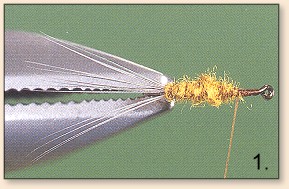
1. Fix hook in vise and layer with thread. Form a bump
at the bend, and tie in split hackle fiber tails a bit
longer than the entire hook. Twist fine olive synthetic
dubbing to the thread, and wind a slender and tapered body
forward over two-thirds of the hook shank.
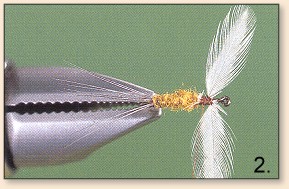
2. Select two matched hen hackles a bit broader
than one hook gap. Measure them the length of the
hook, and clip excess fibers from the stems. Tie
them in together on top of the hook shank, at the
end of the body, and use thread turns to position them
spent. Clip the excess stems.
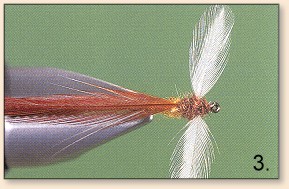
3. Select a hackle with fibers the length of two
hook gaps. Tie it in behind the winds. Twist fine
brown synthetic dubbing to the thread, and form a
thorax with figure 8s between the wings, then tapered
down to the hook eye.
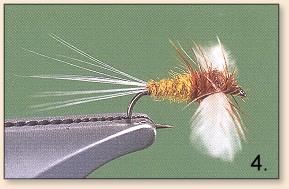
4. Take two to three turns of hackle behind the wings,
two to three in front. Tie it off, clip the stem,
whip-finish the fly, anc clip your thread. Clip the
hackle from the top and bottom of the fly, leaving
enough to support the winds on the water.
More About Tricos:
Tricos hatch in July, August, and September in
waters all across the continent. They usually show
up in the morning. Trout might feed selectively
on the size 22 and 24 nymphs, but it's rarely been
noticed, and its doubtful they become selective
to them. Trout also might focus on the duns,
but again that is not very common. But spinner
falls of these insects are massed, with a whole
flight of them moving over the water and dropping
to the surface almost at one time. Trout, even the
largest of them, come up to concentrate on them when
that happens.
It's not always easy to notice Trico spinner falls.
They can form large, lifting and falling balls in the
air, impossible to miss if the light strikes them right.
But they can also move over the water and show up on
the surface as if by magic. If you see trout that
appear to be rising to nothing, get your nose next to
the water, or better yet seine the currents with a net,
and look closely to see what shows up. If it's Trico
spinners, you'll need to match them to take trout.
~ DH
Credits: From Matching Mayflies,
by Dave Hughes, published by Frank Amato Publications.
We appreciate use permission.
|

